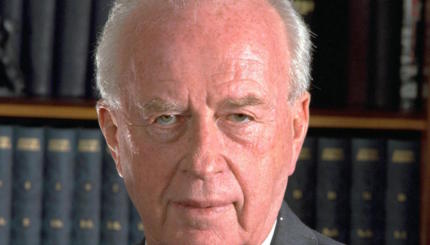The musical traditions the world over are heard in the fusion that is today popular Israeli music. Now for the first time, Ethiopian music has gone mainstream in a unique and eclectic new album that showcases Israel’s ethnic diversity. This article first appeared in the Jerusalem Report magazine’s March 24, 2003, edition and is reprinted with permission.
It all started when Idan Raichel bought a simple music-recording program for his PC. Raichel was 23 years old, a year out of the army, and living at home with his parents in Kfar . He set up his computer in the basement and began inviting people over to record Hebrew and Amharic songs, instrumentals, love letters, and even portions of the Bible.
The Idan Raichel Project
Late last year, two years after he began recording the eclectic and highly melodic tracks, Raichel, who by now was playing piano with the popular Israeli singer Ivri Lider, sent out a sample tape to record companies “as a business card”–proof of what he could do as a producer. Guy Gidor, the producer who received his tracks at Helicon Records, saw the potential in Raichel’s four sample songs, and asked the artist to bolster them with seven more. Gidor had the songs remixed in a studio in London and released them in Israel in December as an album, “The Idan Raichel Project.” Almost immediately, its first single soared to the top of the local charts, and by the end of February 2003, the album had sold over 25,000 copies.
Despite the success, many critics aren’t raving. Gidi Avivi, a music critic for the daily Ha’aretz, for instance, wrote that “with all of the enjoyment involved in humming Hebrew tunes dipped in Ethiopian musical influence, it’s hard to recognize anything beyond a sweet, superficial coating on a rich and complex culture… It hints at the fact that you need not be Dr. Livingstone to walk around in circles.”

Help us keep Jewish knowledge accessible to millions of people around the world.
Your donation to My Jewish Learning fuels endless journeys of Jewish discovery. With your help, My Jewish Learning can continue to provide nonstop opportunities for learning, connection and growth.
But “The Idan Raichel Project” is more than a circular route; in fact, its success may be, in and of itself, a sign of progress. The euphonious mix of songs compiled in the album marks–albeit among other things–the first time Ethiopian music has hit the big time in Israel. The disc is neither simply exotic nor provincial–it’s a mix of the two.
Sample the TunesClick to listen to samples of the following music:
|
Raichel sings on only one of the tracks, “Hinekh Yafah” (Thou Art Fair). The other vocalists have their origins in Ethiopia, Curaçao and Israel. But he wrote the words and melodies to most of the songs.
A Smash Hit
So far, he seems to be taking his accomplishment in stride. He takes orders from his PR lady, he answers his own phone, and he seems unlikely to trash a hotel room, just because he can, anytime soon. He also still lives in the basement of his parents’ home. “It’s just music,” he says of his recent success, between careful bites of his chicken sandwich in a Tel Aviv café. “It can come and it can go.”
But the dreadlocked, lanky 25-year-old’s hit single, “Bo’ee” (Come), isn’t about to disappear. Its sweet melody invites you to sing along, and doesn’t let you stop; it’s already enough of a local icon that a cell-phone company offers it as an alternate ring.
Although many Israeli musicians have succeeded in blending the local pop beat with ethnic themes–mostly the East-West fusion of Sephardi rhythms and Israeli pop–the Ethiopian community, which has a longstanding musical and artistic tradition, has not even flirted with the phenomenon of stardom in Israel, certainly not on its own. In 1991, Shlomo Gronich, a fixture on the pop circuit who has experimented with an array of different sounds, went to a Haderah high school and picked 11 Ethiopian adolescents to sing along with him on a music show for educational television. The show matured into an album, but despite the chanting, the words were in Hebrew and the message was not the students’ own.
Raichel’s album is more authentic–it begins with a recording of traditional Ethiopian prayers for the New Year and it has four songs that are delivered solely in Amharic–but it is also a fusion. The majority of the tracks weave Amharic and Hebrew, traditional and pop. “For Israelis, it’s hard to listen to Ethiopian music. But when it comes in an Israeli wrapper, it’s much more accessible,” he says, noting the similarity between his Project and Tea-Packs, the band, led by Kobi Oz, that successfully mixes rhythms and themes with Israeli pop.
But Raichel’s album is more diverse than just East meets West. Religious texts are read in Amharic with a quivering cello riff in the background; a traditional Amharic song is introduced by a Caribbean-inflected English blessing; and some of the Hebrew songs, which start out as straight-laced pop renditions, culminate in chanting that betrays Raichel’s affinity for the modern-classical Arabic singers Farid al-Atrash and Um Kulthum.
The Path to Diversity
The path to all of this diversity began with a waltz.
In the fiftth grade, Raichel, who now wears his dreads bundled in a black turban and leans toward the Far East in his fashion sense, was playing waltzes and Israeli folk tunes on his accordion, delighting his parents, both Sabras, and their like-minded Kfar Saba friends. “It didn’t make me the most popular kid in class,” he says in a soft voice, heavy with understatement. “But it was the beginning of my interest in ethnic music.” Before high school, he says, he wasn’t even familiar with Madonna, the Beatles, Neil Young or Pearl Jam, but by the time he’d graduated, with a concentration in music, he’d learned their songs and added jazz and the piano to his repertoire as well. Only after completing his compulsory army service in the Education Corps’ entertainment troupe, however, did he first encounter African roots music–the kind he today likes best.
At Hadasim, a boarding school north of Tel Aviv for 5th-12th graders, many of them new immigrants from Russia and Ethiopia, Raichel taught–“actually, mostly learned about”–music. “The kids there were into a lot of rap, reggae and traditional Amharic music,” he says. “What really grabbed me was that in spite of the poor quality of the tapes they listened to, the singers’ rich voices sparkled through the static. You see, I hardly sing on my album because my voice is really not special. These musicians use their voices like instruments. In their society, somebody like Bob Dylan would never have made it.”
After a year in the job, Raichel decided that he would, like his friend Ivri Lider–a musician who “discovered” Raichel playing piano in a Tel Aviv club over four years ago, and hired him to play in his band–begin to record music from home. He recorded a song by Ortal Afek, a friend from the army ( “Speaking Silently,” the album’s second single, which by late February was also headed toward the top of the charts), and at the same time began to seek out the “roots” voices that he’d grown enchanted with. “I used to prowl around the old central bus station region in Tel Aviv”–an ethnically diverse, low-income area–“and look for flyers announcing the kind of ethnic shows that don’t make the entertainment guides,” he says.
Some of the most compelling songs on the album were recorded by artists whom Raichel met completely by chance. Mimi Yosef, the 22-year-old Ethiopian-born woman who reads a letter, of her own composition, to a departed lover, on the hit song “Come,” used to work at a gas station near Raichel’s home. After he befriended her, he asked whether she did any writing; she said no. But he was so impressed by her intelligence that he asked her to compose something for the album.
He made Zena Adchanani’s acquaintance in a crowd. “I was at the airport to meet a friend,” he says. “Adchanani was waiting next to me for some friends to come in from Ethiopia. I told him about my project and asked whether he might know some people who’d be interested in recording music. Turns out, he’s the director of Natala, the Ethiopian Theater in Jerusalem, and he knows more than a few people.”
Adchanani introduced him to Sergio Brahms, a Curaçao-born musician who sings the sometimes swaying, sometimes stomping, Caribbean “Brong Faya” on “The Idan Raichel Project,” and plays the electric guitar on the traditional Ethiopian track “Ayal Ayale.” Zamanwit Zoë Gadmu, the Ethiopian vocalist in “Ayal Ayale,” was also introduced to Raichel by Adchanani, who contributed to the album as well. Adchanani and Raichel come together on “Thou Art Fair,” a track that weaves Raichel’s soft piano playing and almost prayerful voice with Adchanani’s spiritual chanting. The words, which Raichel says were inspired in large part by the third chapter of Solomon’s Song of Songs, describe a man waiting for a woman to come to him “from the desert, from a faraway land, on the wings of a big bird. To my home.”
Raichel’s affinity for Jewish texts runs throughout the album. During the early period of recording, he began to show up at the Ethiopian synagogue near his home. “And then one time I joined them on Sigd, a mid-winter celebration they mark by making a pilgrimage to Jerusalem.”
Their prayers moved him to devote the first track of the album to a prayer service that includes a New Year’s blessing and the Sheheheyanu benediction, which is recited when marking a special event. “It’s to mark the first song,” says Raichel, who asserts that neither he nor his family are religiously observant, but that he does enjoy reading the Hebrew Bible. The final song on the disc, “Time to Live, Time to Die,” is a cello- and chant-backed rendition from the third chapter of Ecclesiastes, translated into Amharic, and spoken, in a reserved yet powerful tone, by Mimi Yosef, the gas-station attendant.
Yet for all of the album’s multiculturalism, a cause to which Raichel seems genuinely dedicated, the record company’s PR consultant, Sharon Malin, would not make it possible for The Report to speak with any of the contributing artists on the album. The soft-spoken and unassuming Raichel was willing, after some nudging, to give out phone numbers of contributing musicians, but Malin was adamant. “It’s simply a conceptual thing,” Malin said. “We want him to be at the center of attention and I’m not willing to have that diverted.” Nothing–not even claims that such an attitude marginalizes the performers that actually stand at the heart of the album’s success–could sway her.
The name of the album also hardly seems to distribute the credit equitably. When asked about naming the album “The Idan Raichel Project,” a far stretch from, for instance, Gronich’s more generous “Shlomo Gronich and the Sheba Youth Choir,” Raichel grows defensive for the first and only time. “What else would you call it?” he asks.
Then he quickly relaxes. “Look, it’s not a 30-person band; it’s me working with 30 different individuals”–all of whom are credited and thanked, as well as pictured, in some cases, on the album. “It’s also not an Ethiopian album. Some of the reviews of the album said it was the worst Ethiopian album of the year; it’s also the worst Hungarian album of the year, because it is neither of those. It’s a project, the Idan Raichel Project.”.


